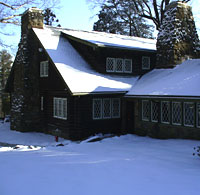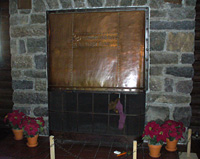Stickley's Copper Arts & Crafts: History Hewn and Hammered
 The Gustav Stickley Museum
The Gustav Stickley MuseumPhotograph by Regina Jasko
Although originating in England, Gustav Stickley's clear concise expression and interpretation of the form in the late 1890's made him the recognizable face of the Arts and Craft movement in the United States. Predominately known for his furniture, Stickley also worked heavily in copper, brass and iron, creating a diverse array of products like lanterns, candle holders, vases, even desk accessories at his metal shop which opened in May, 1902 in Syracuse, New York.
"Drawer pulls, key escutcheons and hinges were his early metalwork which he did concurrently with the furniture, and he outsourced the manufacturing," says Allen Breed, a Trustee of the Stickley Museum at Craftsman Farms in Morris Plains, NJ. "[Take the] pull for example. You have a back plate and a ring; the ring is cast (outsourced) and the plate would have been hammered in-house, then patinated together. To set up a foundry just starting out would have been a little ambitious," Breed said. The museum, actually a custom home built in 1910-1911, contains the single most comprehensive source of Stickley metalwork. Second to that would be Crab Tree Farm outside of Chicago, which also contains Stickley copper work. Other than that notes Breed, individual museums and private collections hold the rest of Gustav Stickley's copper works.
Stickley promoted most of his work, both copper and wood, through his successful magazine, The Craftsman , which he published from 1901 through 1916. In it he spoke about different patinas, hammering techniques, and ways to affect copper. This was, after all, the basis for the Arts and Crafts movement, the idea that everybody could create beautiful designs in their own home. Though other Arts and Crafts metal workers were using copper, like Roycroft and Green & Green, what set Stickley apart was his understanding of chemicals.
"His innovation was in his patinas, which were considered trade secrets," Breed acknowledged. "Gustav had a two-toned patina for copper. A dark patina would be lightly run off so the high points of the copper would be cleaned and brighter, but the craters made by the hammer would still have black in it. Then he'd overlay a brown patina. It gave the pieces a third dimension," Breed said. The result was patinas that showed more variety than his competitors and an increasing demand for his work.
 Copper fireplace cover by Gustav Stickley
Copper fireplace cover by Gustav Stickley Photograph by Regina Jasko
Stickley was also ahead of his time with his use of multi-level marketing. He assertively promoted his designs across the nation through his magazine.
" The Craftsman promoted a full product line; lighting, furniture, door knockers, decorative hinges and much more," Breed says.
He not only wrote articles about various patinas and the best ones for iron, brass and copper, but kept readers enthralled with his clean, simple designs. Though it's widely known that Stickley copied initial designs from several British companies, according to Breed, he improved on them, expanding the patinas, using heavier gauge copper, and formed and hammered his metalwork differently.
Copper was the metal second only to silver, but few could afford a silversmith at the time. "Copper was easily worked, the patination was reasonably well developed, and certainly in Europe, the working of metal, especially copper, was already advanced," Breed says.
In today's market, Stickley's original metal work still commands a respectable price. An original exterior lantern for example can fetch upwards of $2,000, while his furniture will bring in over $10,000. This shouldn't suggest that his copper and metal work aren't well known.
"People may be more aware of his metalwork than they know. They just don't have a name to put to it," Breed says. The Stickley designs are nearly universal by now.
At the Stickley Museum at Craftsman Farms, a dozen copper light fixtures in the living room, original to the house, are always on display. Additionally there are candle holders, crumbers, strap hinges, and half a dozen copper trays on the sideboard in the dining room.
Perhaps the best commentary about Stickley's work comes from the man himself. In The Craftsmen he once wrote that his hope was that the magazine would demonstrate, "how to create an environment where simple needs are met in a simple direct way; in pointing out how a home should be a place where lives may be lived in happiness, and where good work may be done because of the silent influences of space, freedom and sincerity."
Resources:
Also in this Issue:
- StudioEIS Brings History to Life through Bronze
- Fountains by Design
- Mike Dumas Copper Designs: Where Old World Meets Southwest
- Stickley's Copper Arts & Crafts: History Hewn and Hammered
- 19th Annual Celebration of Fine Art in Scottsdale
